A fool-proof Iyer-style Sambar Powder recipe using basic pantry staples! This aromatic masala is made by roasting lentils and whole spices, then grinding them to perfection. A staple in South Indian kitchens, this homemade sambar podi elevates everyday meals with bold, comforting flavors. Make a big batch and store it for months—so your sambhar is always just a scoop away!
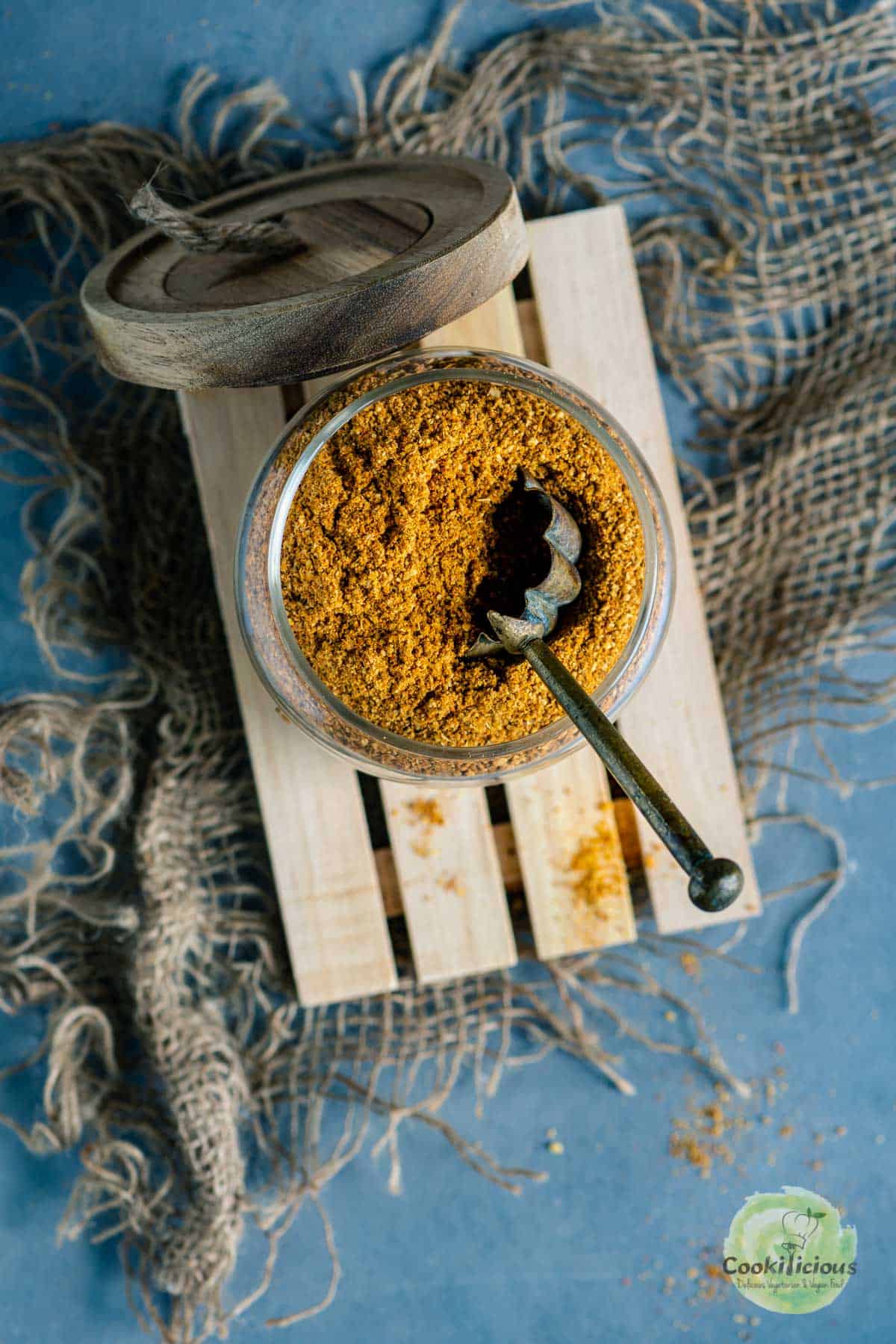
Jump to:
What is Sambar Powder
Sambar Powder (or Sambar Podi, as we call it in Tamil) is an essential South Indian spice blend used to flavor Sambar—a comforting lentil-based stew. It’s made by roasting and grinding lentils and whole spices, creating a fragrant and flavorful masala.
There are many regional and family-specific variations of homemade sambar powder. For instance, our Iyer-style recipe doesn’t include asafoetida or curry leaves in the mix—we add those fresh while making sambar. Some versions also include mustard seeds, urad dal, or even coconut. We also do not add any salt to the spice blend.
Note: Traditional South Indian sambar powder is not the same as Madras curry powder sold in the US, which often contains cayenne pepper and has a different flavor profile.
The Iyer-style sambar podi I share today is a cherished family recipe, passed down through generations. This is how my Pati (grandmom) made it. After my mom, it’s my aunt who lovingly prepares this homemade sambar masala in bulk and sends it to us in the US. Featuring this heirloom spice blend on the blog is my way of preserving our South Indian culinary heritage for generations to come.
Homemade Spice Mixes – An Indian Kitchen Essential
Every Indian household relies on traditional homemade spice mixes to bring flavor and ease to everyday cooking. Whether prepared at home or bought from the store, these spice blends are the backbone of most recipes—and food often feels incomplete without them.
Making spice powders at home is surprisingly simple. The basic method involves dry roasting the ingredients and then grinding them into a fine powder. Traditionally, ingredients were sun-dried for a day or two and then sent to a local flour mill for bulk grinding—especially in large families.
Some of the homemade spice blends I can’t live without in my kitchen include: Coriander Cumin Powder, Turmeric Powder, Molagapodi, and Garam Masala.
Why Make It
- ✅ An authentic Iyer-style Sambar Powder recipe
- 🌱 Naturally vegan, nut-free, and gluten-free
- 🧂 No salt, no oil, and no preservatives
- 🧡 Tastes more authentic and flavorful than store-bought
- 💰 Homemade is cheaper and more wholesome
- 🧴 No artificial colors or additives
- 🥄 Made using just a few basic ingredients
- 🔥 Simply roast and grind—that’s it!
- 🕒 Ready in just 20 minutes
- 📦 Make in bulk and store for up to 6 months
Ingredients needed 🧾
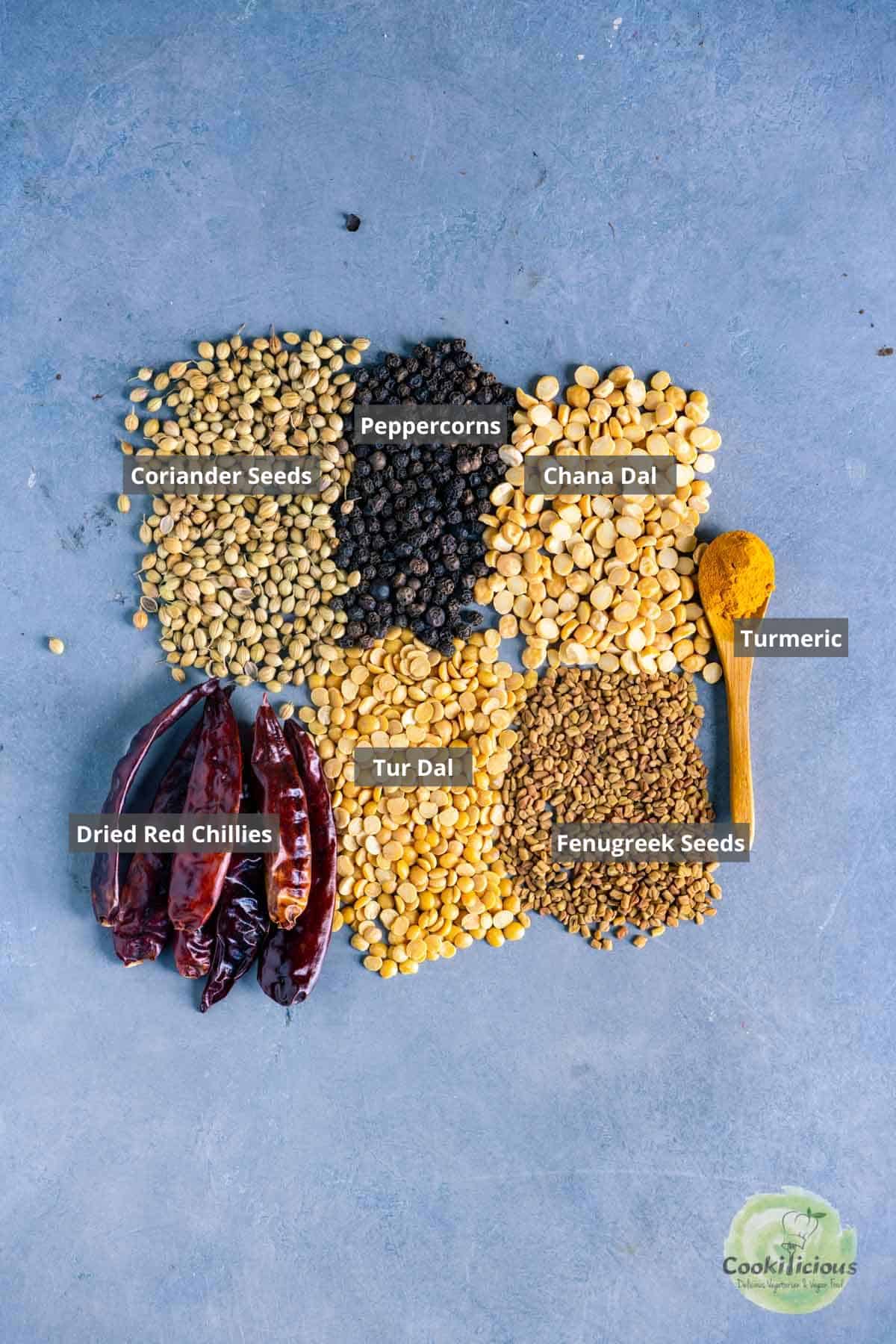
🌾 Lentils
For this Iyer-style sambar powder, you’ll need two types of lentils:
- Organic Tur Dal (Toor Dal)
- Chana Dal
These form the base of the homemade sambar masala. Both are easily available at Indian grocery stores or online on sites like Amazon.
🌶️ Whole Spices
This aromatic South Indian spice blend is made with:
- Dried Red Chillies – Use Madras, Kashmiri or Bydagi for vibrant color and mild heat
- Black Peppercorns
- Coriander Seeds
- Fenugreek Seeds
- Turmeric Powder – Adds color, flavor, and acts as a natural preservative
These spices bring depth, warmth, and authenticity to your sambar podi.
🍳 Equipment Needed
High powder blender or Mixer Grinder – To grind the roasted ingredients into a fine, aromatic powder
Nonstick pan or Heavy-bottomed Kadai – For evenly roasting the spices and lentils
How to make it 🔪
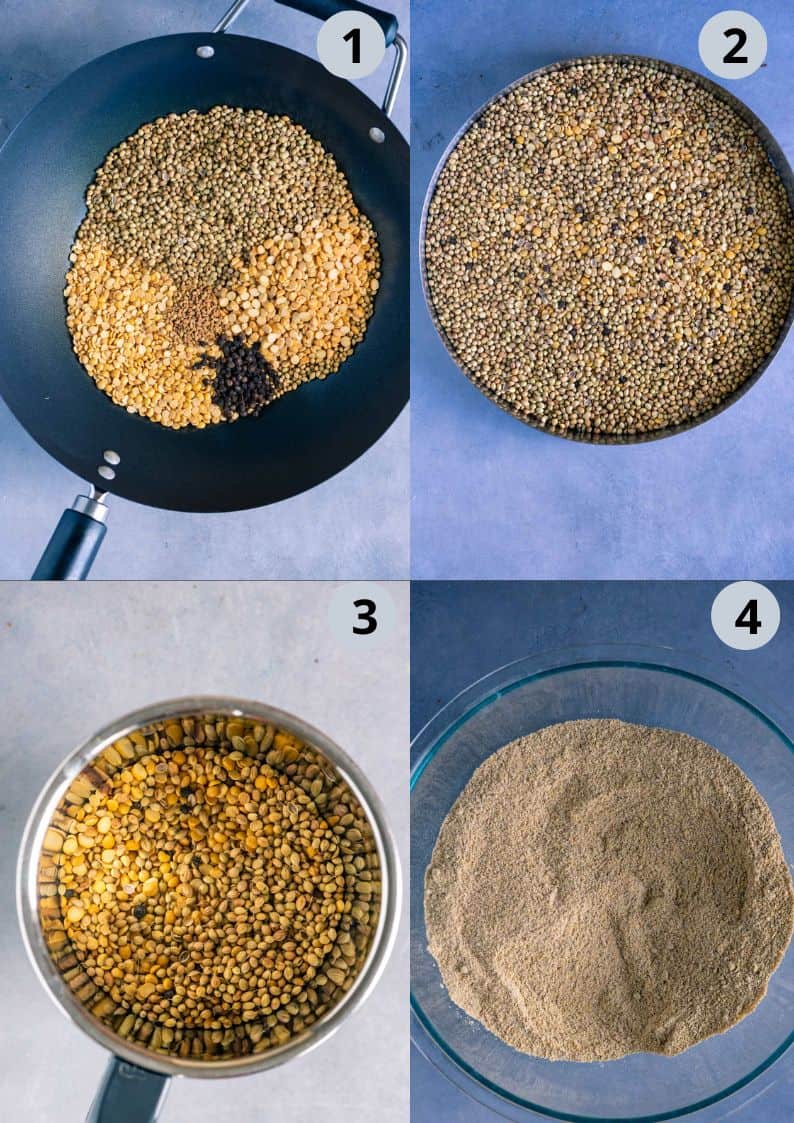
- In a heavy-bottomed or non-stick pan, dry roast the tur dal, chana dal, coriander seeds, peppercorns, and fenugreek seeds over low to medium heat. Stir continuously until they turn slightly golden and release a nutty aroma—this takes about 5–6 minutes. You can roast them all together or separately.
- Transfer the roasted ingredients to a plate and allow them to cool down completely. This prevents moisture buildup when grinding.
- Add the cooled ingredients to a blender or mixer grinder. Grind in batches if needed.
- Grind until you get a fine, aromatic spice powder. Remove the ground sambar podi into a clean, dry mixing bowl.
Want to save this recipe?
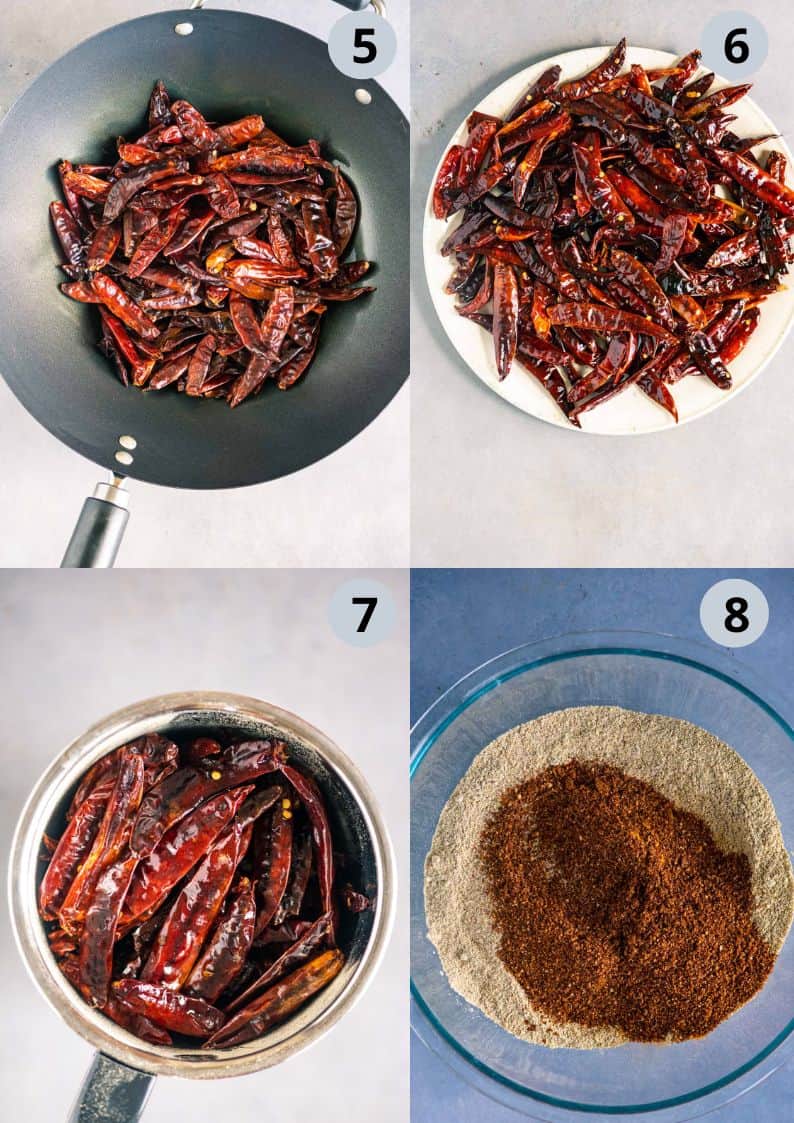
- In the same pan, dry roast the dried red chillies (Kashmiri or Bydagi) over low to medium heat for about 4–5 minutes, until they turn slightly darker and release a smoky aroma. You may add 1 teaspoon of oil at this stage to help them roast evenly and reduce bitterness.
- Transfer the roasted chillies to a plate and let them cool completely.
- Then grind them into a fine powder using a blender or spice grinder.
- Add the ground chilli powder to the same bowl with the earlier spice mix.
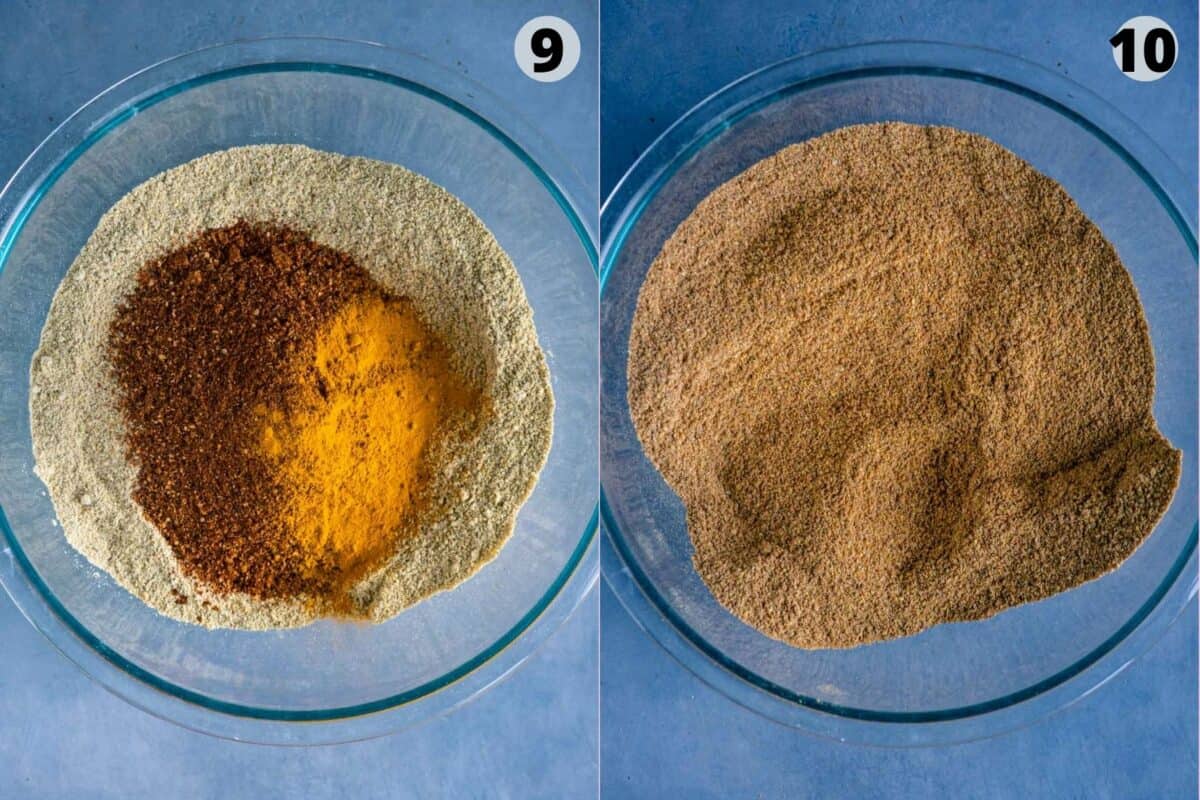
- Now add the turmeric powder to the bowl with the ground spice mix. Turmeric not only adds color but also acts as a natural preservative.
- Mix everything thoroughly to ensure a uniform texture and color. The final sambar powder should be an aromatic blend with a slightly gritty texture—almost fine, but not completely smooth. A few tiny grits are ideal and add character to the masala, just like traditional homemade versions. Sifting is optional—I usually skip it. If the powder feels too coarse, you can either grind it again or pass it through a fine sieve.
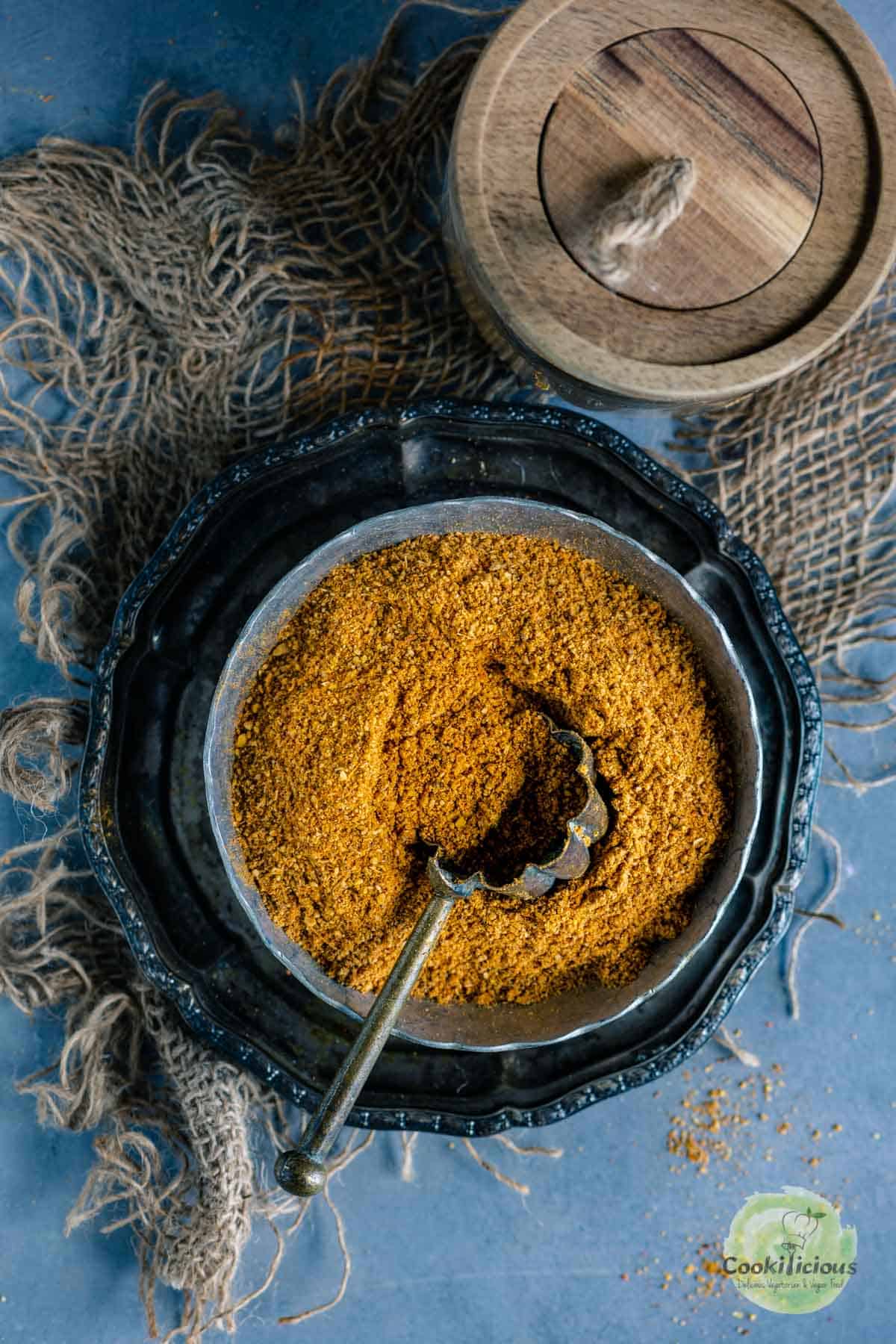
Serving suggestions 🍽
This versatile homemade spice mix is perfect for traditional sambar, kootu, and Potato curry recipes. It can also be used as a substitute for curry powder in many dishes. Because this blend contains black pepper, it works wonderfully as a rasam powder alternative when making rasam.
Beyond sambar, you can enhance a variety of South Indian dishes like Tomato Rice, Capsicum Rice, Vazhakai Poriyal (Raw Banana Fry), and Beetroot Poriyal by adding a spoonful of this flavorful sambar masala podi. It instantly elevates the taste and adds authentic depth to your meals.
Top recipe tips 💭
Ensure all ingredients are clean and completely dry before roasting—this is crucial for shelf life. There's no need to rinse the lentils. Simply check and remove any stones or impurities before using. Coriander seeds add not only a warm, citrusy flavor but also help increase the volume of the sambar powder. For added depth, you can include 2 teaspoons of fennel seeds or garlic powder if you enjoy that flavor in your sambhar.
This recipe yields about 4 cups of Iyer-style sambhar powder. You’ll need only 1–2 tablespoons per recipe, depending on the dish you're preparing.
Recipe FAQs 📖
Roasting the spices is a key step in making flavorful Iyer-style sambar powder. It not only enhances the natural aroma and flavor of the spices but also makes them easier to grind into a uniform powder.
Always roast the ingredients over a low to medium flame to prevent burning.
Stir continuously for even roasting and to avoid scorching.
Let the spices cool down completely before grinding—this preserves their essential oils and ensures a smooth, consistent texture.
Skipping this step can result in a dull, raw-tasting masala that won’t deliver the rich flavor profile that homemade sambhar podi is known for.
For an authentic Iyer-style sambhar podi, use dried red chillies, preferably the Gundu Madras, Kashmiri or Bydagi varieties. These chillies provide vibrant color with mild heat—perfect for balancing flavor without overwhelming spice.
While roasting the dried chillies, add 1 teaspoon of oil to mellow the heat and prevent it from irritating your nose.
If Kashmiri or Bydagi chillies aren’t available, you can substitute with Indian red chilly powder (spicy or mild), mixed with turmeric powder.
Grind the chillies separately from the lentils, as lentils take longer to grind and mixing them can cause uneven powder texture.
To achieve a deeper red color without adding too much heat, increase the quantity of dried red chillies and balance it by adding more turmeric or using mild Kashmiri chilli powder.
To get the perfect Iyer-style sambar powder consistency, use a high-speed mixer grinder. Make sure the grinder jar is clean and completely dry before starting.
Grind in small batches to avoid overloading the grinder and ensure even grinding.
Scrape down the sides of the jar frequently to blend all ingredients uniformly.
The goal is a fine yet slightly gritty powder—not completely smooth—preserving the traditional texture and flavor.
If grinding. alarge batch, take short breaks during grinding to prevent the jar from overheating, which can damage your grinder and affect the spice quality.
Stop grinding immediately if the jar feels hot to the touch.
Following these tips will help you achieve a consistent, aromatic homemade sambar podi perfect for all your South Indian recipes.
Yes! Instead of roasting on the stovetop, you can roast the lentils and spices in the oven for an easy, hands-off method.
Preheat your oven to 350°F (175°C).
Spread the tur dal, chana dal, and fenugreek seeds evenly in a single layer on a cookie sheet or baking tray.
Roast them for about 5 minutes.
Turn off the oven, then add the remaining spices and let everything sit inside the warm oven for another 10 minutes to gently toast.
For more even roasting, you can remove the lentils after 5 minutes and then roast the other spices separately. Adjust the roasting time as needed, ensuring all ingredients are spread out in a single layer for best results. Be careful to not burn them.
Yes! If you live in a hot and sunny climate, you can follow the traditional sun-drying method used in many South Indian households.
Spread the lentils and spices out in a single layer on a tray or large plate.
Leave them uncovered under direct sunlight for 1–2 days, making sure to keep them in a clean, dust-free, insect-free area.
Once they are sun-dried and crisp, grind them into a fine powder just like you would with roasted spices.
This age-old technique not only saves fuel but also gives the sambar podi a deep, earthy aroma that many believe enhances the final flavor.
To keep your homemade sambhar powder fresh and flavorful, always store it in a clean, dry, airtight container. Moisture is the biggest enemy—it can cause the spice mix to spoil quickly.
Typically, this Iyer-style sambhar masala stays at its best for 6 to 8 months, though the aroma and potency gradually fade after that.
Depending on your local climate:
Store it on your kitchen shelf or in the pantry if you live in a cool, dry place.
In hot or humid conditions, it’s best to keep the container in the refrigerator.
Important: Never use a wet spoon or touch the powder with wet hands to prevent moisture contamination. For longer-term storage, consider vacuum-packing the sambar powder and freezing it—this preserves its flavor and shelf life.
Recipes using sambhar powder
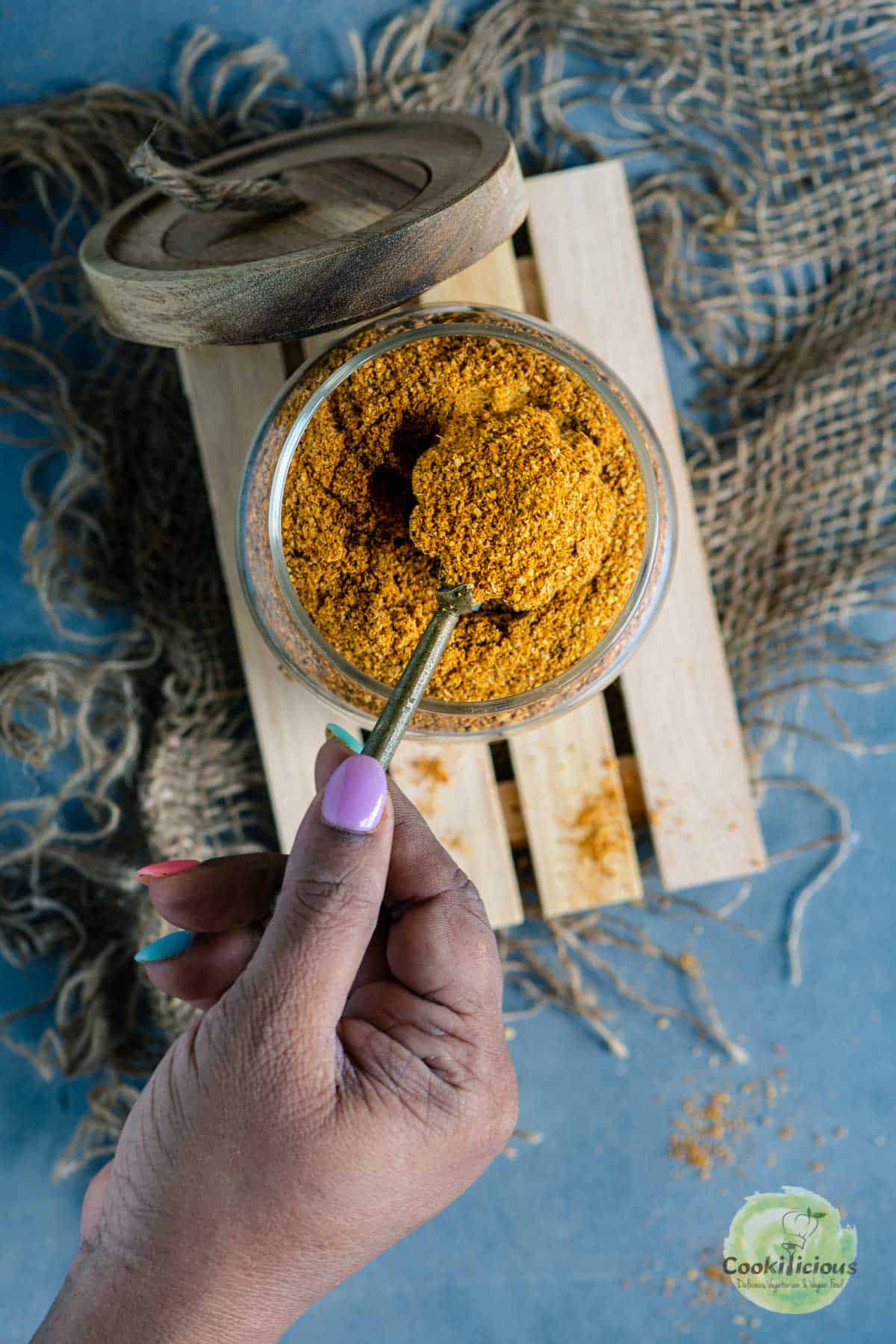
⭐️ Subscribe to the Cookilicious Newsletter and receive new recipes straight to your inbox! You'll receive my FREE Vegan Beginner's guide as a gift. Ready to elevate your cooking game? Purchase my Cookbook - The Essential Vegan Indian Cookbook today!
Recipe 📖
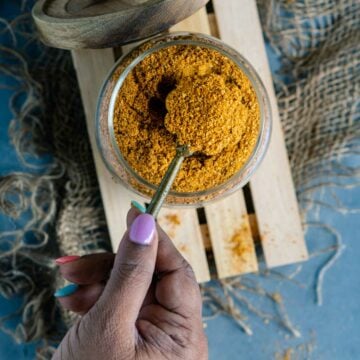
Authentic Iyer-Style Sambar Powder Recipe
Equipment
Ingredients
- 1 cup Tur dal
- ¼ cup chana dal
- 2 cups coriander seeds
- 1 teaspoon fenugreek seeds
- 2 teaspoon peppercorns
- 100 gms dried red chillies
- 3 teaspoon turmeric powder
Instructions
- In a heavy-bottomed or non-stick pan, dry roast the tur dal, chana dal, coriander seeds, peppercorns, and fenugreek seeds over low to medium heat. Stir continuously until they turn slightly golden and release a nutty aroma—this takes about 5–6 minutes. You can roast them all together or separately.
- Transfer the roasted ingredients to a plate and allow them to cool down completely. This prevents moisture buildup when grinding.
- Add the cooled ingredients to a blender or mixer grinder. Grind in batches if needed.
- Grind until you get a fine, aromatic spice powder. Remove the ground sambar podi into a clean, dry mixing bowl.
- In the same pan, dry roast the dried red chillies (Kashmiri or Bydagi) over low to medium heat for about 4–5 minutes, until they turn slightly darker and release a smoky aroma. You may add 1 teaspoon of oil at this stage to help them roast evenly and reduce bitterness.
- Transfer the roasted chillies to a plate and let them cool completely.
- Then grind them into a fine powder using a blender or spice grinder.
- Add the ground chilli powder to the same bowl with the earlier spice mix.
- Now add the turmeric powder to the bowl with the ground spice mix. Turmeric not only adds color but also acts as a natural preservative.
- Mix everything thoroughly to ensure a uniform texture and color. The final sambar powder should be an aromatic blend with a slightly gritty texture—almost fine, but not completely smooth. A few tiny grits are ideal and add character to the masala, just like traditional homemade versions. Sifting is optional—I usually skip it. If the powder feels too coarse, you can either grind it again or pass it through a fine sieve.
- Store in an airtight container and use in any recipe that calls for sambar powder.

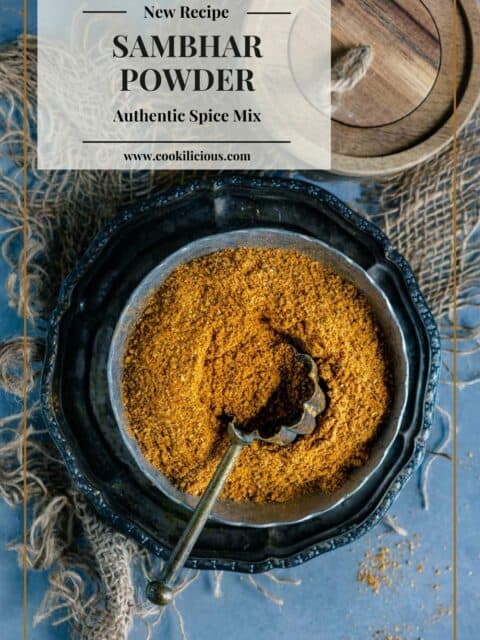
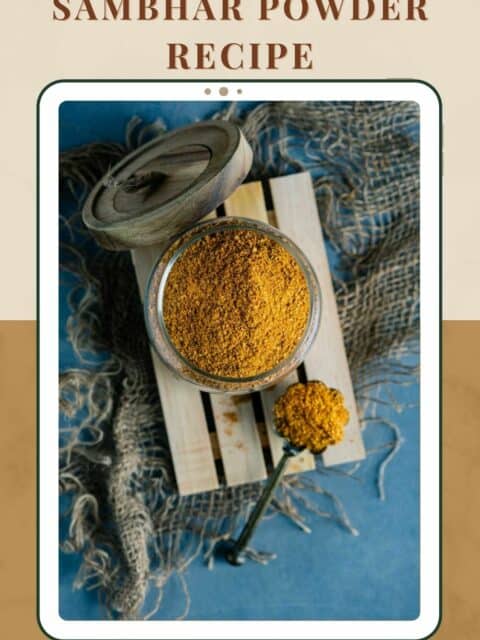
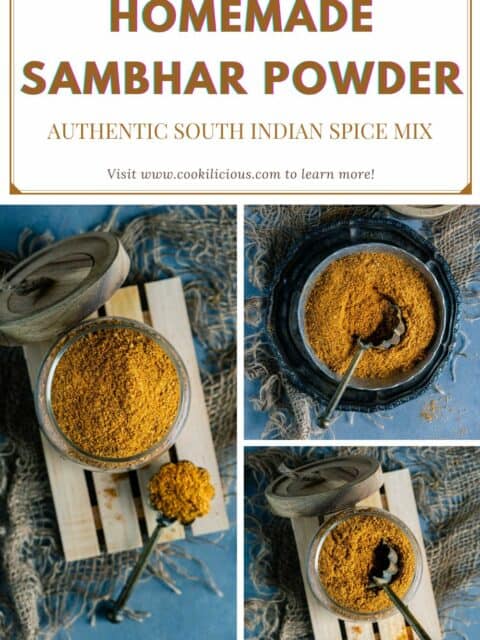
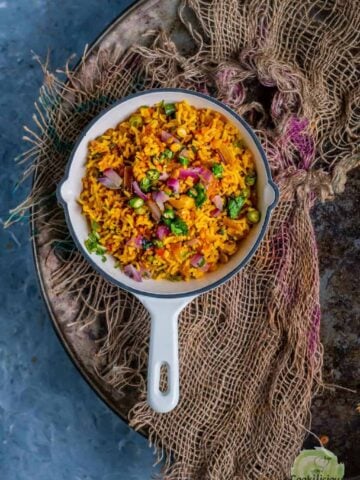
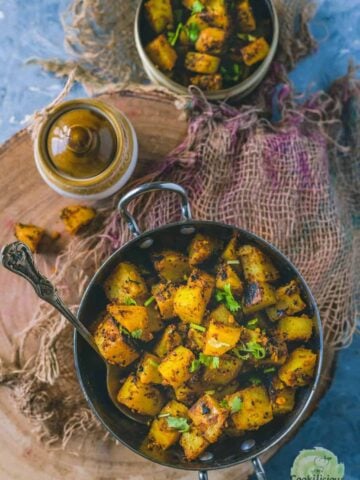
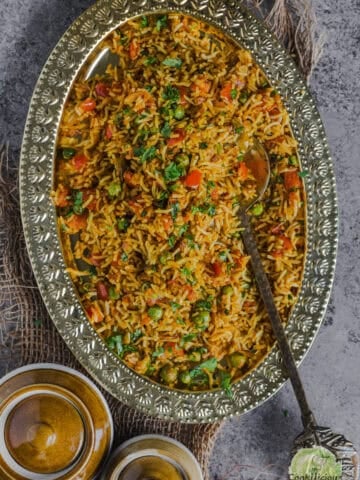
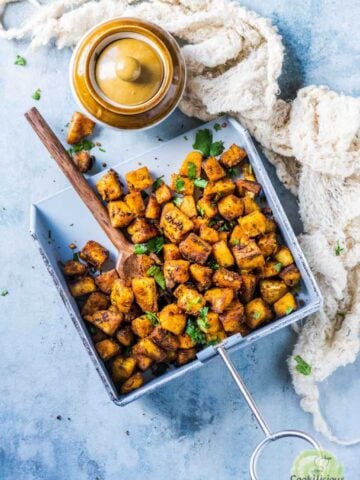
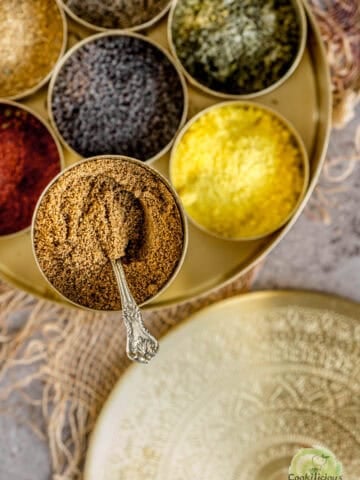
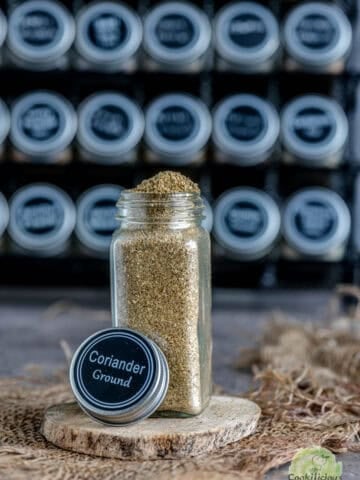
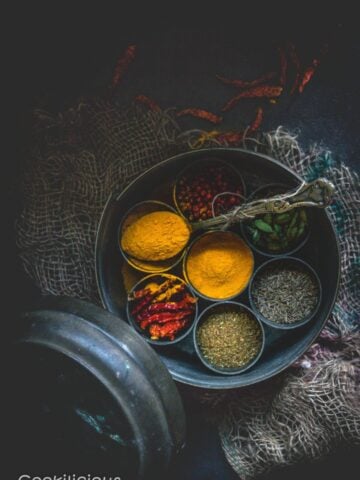
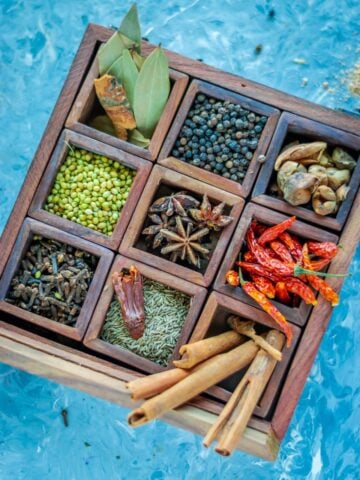
Rohit says
A regular recipe in our kitchen.
Priya says
Thank you.
Dee says
I live in the U.S. and did buy a Preethi Eco Plus online. It did have the 1.5 Liter container which I do not need as I use a Vitamix and Cuisinart for mixing-grinding. I have used several other mixers which weren’t that great and have tossed them. The Preethi Eco Plus leaked and the lids would not tighten. I returned it.
I watch many Indian cooks on YouTube and always admire the mixer grinder that is Stainless steel and has a small footprint.
Can you suggest any mixer grinder that would work for me. It would have to be able to grind into a paste of: fresh ginger, green chilis and garlic.
Many thanks.
Dee
Priya says
Hi Dee, I like https://amzn.to/3CvA5dk Its really good. Its a little expensive but you can use it for everything. Hope this helps.
Dorothy Heldt says
Follow all yr. recipes Priya. Enjoy the authenticity/simplicity. So happy to see the recipes for homemade powders. So much better than store bought. How long could I store them? Also what veggies are best for the sambar? Thank you Dorothy Heldt
Priya says
Hi Dorothy, thank you so much for loving these recipes. Yes, I to prefer them homemade. Shelf life of spice powders are different. I would suggest make in small batches and use as you need. You can store them in an airtight container and in the fridge if you want. For sambhar, check out my sambhar recipe where I have shared what veggies to use. Hope this helps. 🙂
Sangeeta says
Which cup u used?,200ml or 250ml.
Priya says
The cup size doesn't matter. It is the ratio that is important. Use the same cup for measuring all the ingredients. But I used 250ml cup, if that helps.